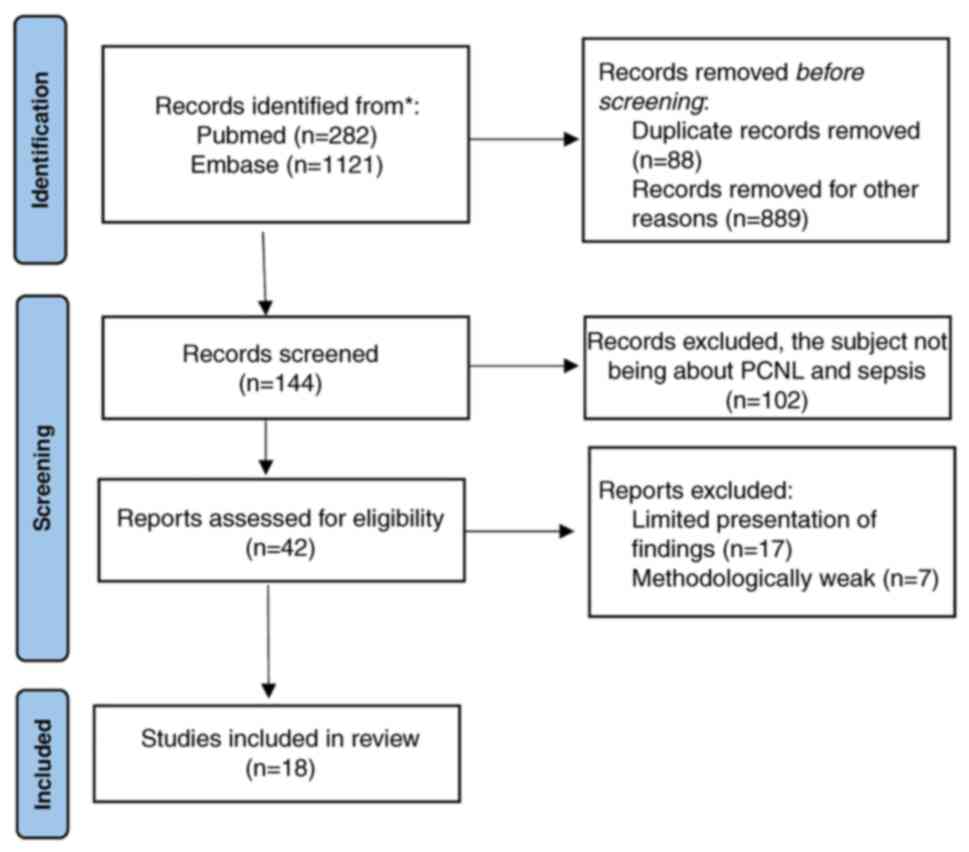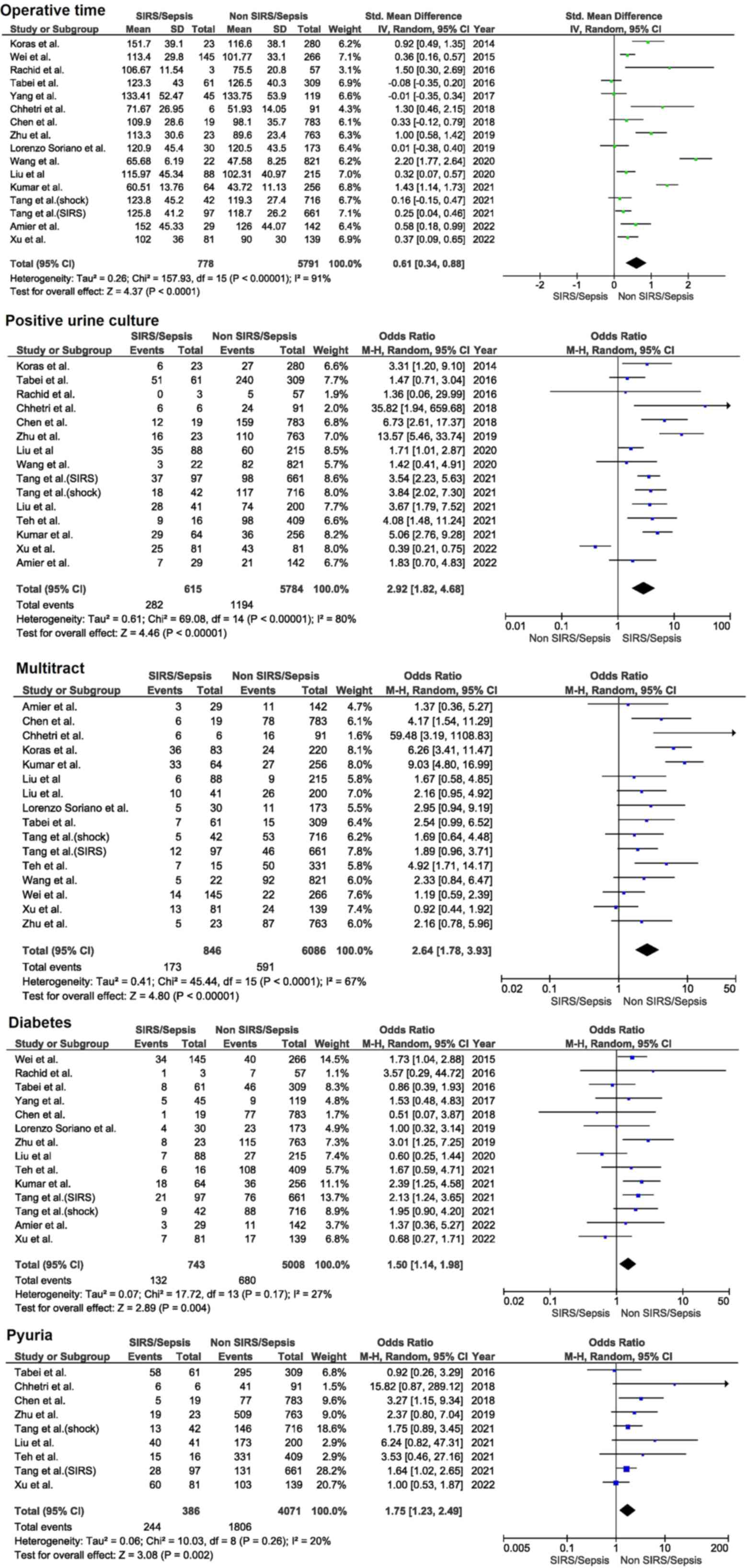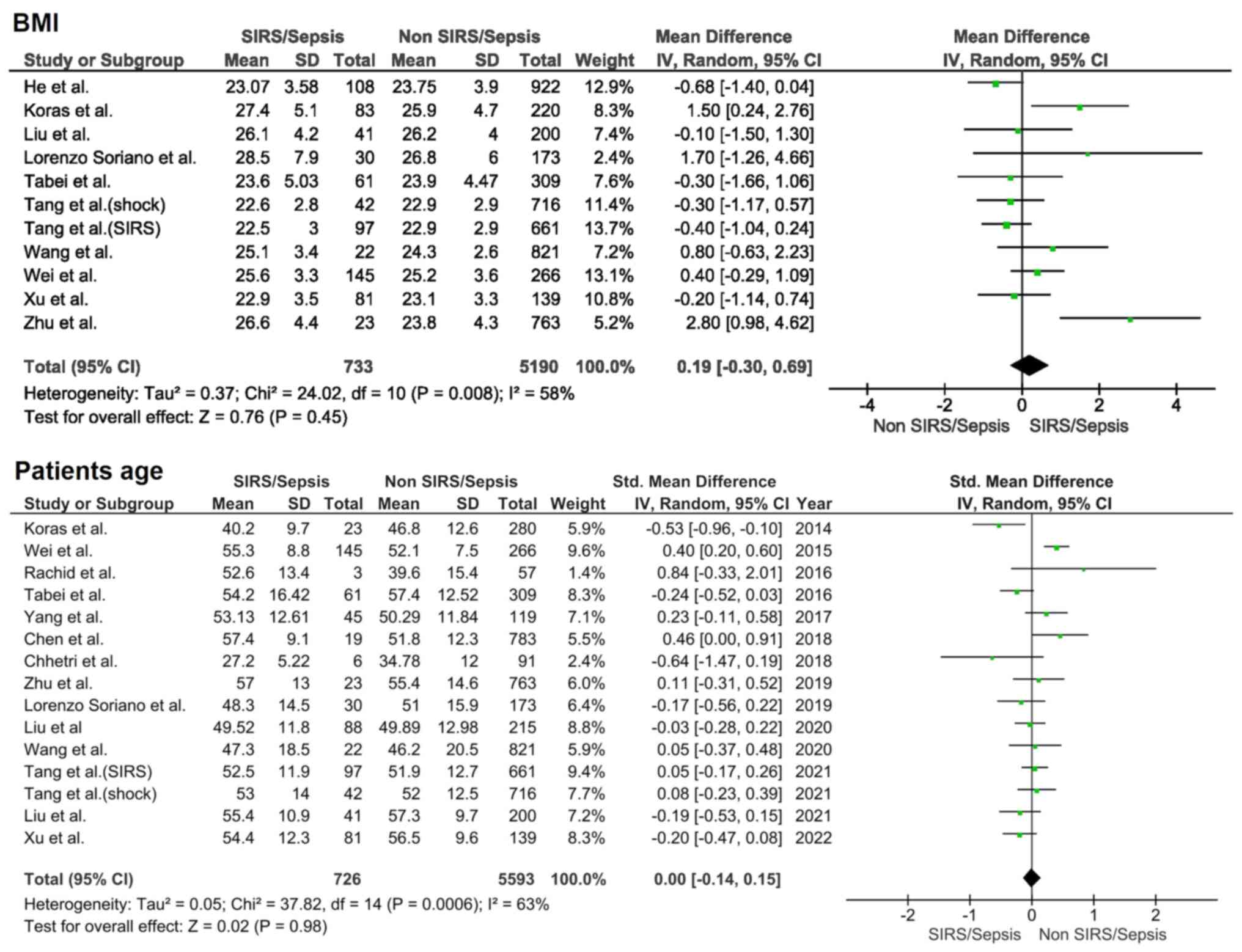|
1
|
Yu J, Guo B, Yu J, Chen T, Han X, Niu Q,
Xu S, Guo Z, Shi Q, Peng X, et al: Antibiotic prophylaxis in
perioperative period of percutaneous nephrolithotomy: A systematic
review and meta-analysis of comparative studies. World J Urol.
38:1685–1700. 2020.PubMed/NCBI View Article : Google Scholar
|
|
2
|
Jiang Y and Zhang J, Kang N, Niu Y, Li Z,
Yu C and Zhang J: Current Trends in percutaneous nephrolithotomy in
China: A spot survey. Risk Manag Health Policy. 14:2507–2515.
2021.PubMed/NCBI View Article : Google Scholar
|
|
3
|
Türk C, Petřík A, Sarica K, Seitz C,
Skolarikos A, Straub M and Knoll T: EAU guidelines on
interventional treatment for urolithiasis. Eur Urol. 69:475–482.
2016.PubMed/NCBI View Article : Google Scholar
|
|
4
|
Sharma K, Sankhwar SN, Goel A, Singh V,
Sharma P and Garg Y: Factors predicting infectious complications
following percutaneous nephrolithotomy. Urol Ann. 8:434–438.
2016.PubMed/NCBI View Article : Google Scholar
|
|
5
|
Michel MS, Trojan L and Rassweiler JJ:
Complications in percutaneous nephrolithotomy. Eur Urol.
51:899–906. 2007.PubMed/NCBI View Article : Google Scholar
|
|
6
|
Yang Z, Lin D, Hong Y, Hu M, Cai W, Pan H,
Li Q, Lin J and Ye L: The effect of preoperative urine culture and
bacterial species on infection after percutaneous nephrolithotomy
for patients with upper urinary tract stones. Sci Rep.
12(4833)2022.PubMed/NCBI View Article : Google Scholar
|
|
7
|
Page MJ, McKenzie JE, Bossuyt PM, Boutron
I, Hoffmann TC, Mulrow CD, Shamseer L, Tetzlaff JM, Akl EA, Brennan
SE, et al: The PRISMA 2020 statement: An updated guideline for
reporting systematic reviews. BMJ. 372(n71)2021.PubMed/NCBI View
Article : Google Scholar
|
|
8
|
Amier Y, Zhang Y, Zhang J, Yao W, Wang S,
Wei C and Yu X: Analysis of preoperative risk factors for
postoperative urosepsis after mini-percutaneous nephrolithotomy in
patients with large kidney stones. J Endourol. 36:292–297.
2022.PubMed/NCBI View Article : Google Scholar
|
|
9
|
Chen D, Jiang C, Liang X, Zhong F, Huang
J, Lin Y, Zhao Z, Duan X, Zeng G and Wu W: Early and rapid
prediction of postoperative infections following percutaneous
nephrolithotomy in patients with complex kidney stones. BJU Int.
123:1041–1047. 2019.PubMed/NCBI View Article : Google Scholar
|
|
10
|
Chhetri RK, Baral S and Thapa N:
Prediction of infectious complications after percutaneous
nephrolithotomy. J Soc Surg Nepal. 21:12–18. 2018.
|
|
11
|
He Z, Tang F, Lei H, Chen Y and Zeng G:
Risk factors for systemic inflammatory response syndrome after
percutaneous nephrolithotomy. Prog Urol. 28:582–587.
2018.PubMed/NCBI View Article : Google Scholar
|
|
12
|
Koras O, Bozkurt IH, Yonguc T, Degirmenci
T, Arslan B, Gunlusoy B, Aydogdu O and Minareci S: Risk factors for
postoperative infectious complications following percutaneous
nephrolithotomy: A prospective clinical study. Urolithiasis.
43:55–60. 2015.PubMed/NCBI View Article : Google Scholar
|
|
13
|
Kumar GC, Devraj R, Sagar V, Chandraiah R,
Prasad D and Ch R: Factors determining postoperative infectious
complications of percutaneous nephrolithotomy: Experience from a
single center. Int J Health Clin Res. 4:127–130. 2021.
|
|
14
|
Liu J, Zhou C, Gao W, Huang H, Jiang X and
Zhang D: Does preoperative urine culture still play a role in
predicting post-PCNL SIRS? A retrospective cohort study.
Urolithiasis. 48:251–256. 2020.PubMed/NCBI View Article : Google Scholar
|
|
15
|
Liu J, Yang Q, Lan J, Hong Y, Huang X and
Yang B: Risk factors and prediction model of urosepsis in patients
with diabetes after percutaneous nephrolithotomy. BMC Urol.
21(74)2021.PubMed/NCBI View Article : Google Scholar
|
|
16
|
Lorenzo Soriano L, Ordaz Jurado DG, Pérez
Ardavín J, Budía Alba A, Bahílo Mateu P, Trassierra Villa M and
López Acón D: Predictive factors of infectious complications in the
postoperative of percutaneous nephrolithotomy. Actas Urol Esp (Engl
Ed). 43:131–136. 2019.PubMed/NCBI View Article : Google Scholar
|
|
17
|
Rashid AO and Fakhulddin SS: Risk factors
for fever and sepsis after percutaneous nephrolithotomy. Asian J
Urol. 3:82–87. 2016.PubMed/NCBI View Article : Google Scholar
|
|
18
|
Tabei T, Ito H, Usui K, Kuroda S, Kawahara
T, Terao H, Fujikawa A, Makiyama K, Yao M and Matsuzaki J: Risk
factors of systemic inflammation response syndrome after endoscopic
combined intrarenal surgery in the modified Valdivia position. Int
J Urol. 23:687–692. 2016.PubMed/NCBI View Article : Google Scholar
|
|
19
|
Tang Y, Zhang C, Mo C, Gui C, Luo J and Wu
R: Predictive model for systemic infection after percutaneous
nephrolithotomy and related factors analysis. Front Surg.
8(696463)2021.PubMed/NCBI View Article : Google Scholar
|
|
20
|
Teh KY and Tham TM: Predictors of
post-percutaneous nephrolithotomy sepsis: The Northern Malaysian
experience. Urol Ann. 13:156–162. 2021.PubMed/NCBI View Article : Google Scholar
|
|
21
|
Wang S, Yuan P, Peng E, Xia D, Xu H, Wang
S, Ye Z and Chen Z: Risk factors for urosepsis after minimally
invasive percutaneous nephrolithotomy in patients with preoperative
urinary tract infection. Biomed Res Int.
2020(1354672)2020.PubMed/NCBI View Article : Google Scholar
|
|
22
|
Wei W, Leng J, Shao H and Wang W:
Diabetes, a risk factor for both infectious and major complications
after percutaneous nephrolithotomy. Int J Clin Exp Med.
8:16620–16626. 2015.PubMed/NCBI
|
|
23
|
Xu P, Zhang S, Zhang Y, Zeng T, Chen D and
Wu W, Tiselius HG, Li S, Huang J, Zeng G and Wu W: Preoperative
antibiotic therapy exceeding 7 days can minimize infectious
complications after percutaneous nephrolithotomy in patients with
positive urine culture. World J Urol. 40:193–199. 2022.PubMed/NCBI View Article : Google Scholar
|
|
24
|
Yang T, Liu S, Hu J, Wang L and Jiang H:
The evaluation of risk factors for postoperative infectious
complications after percutaneous nephrolithotomy. Biomed Res Int.
2017(4832051)2017.PubMed/NCBI View Article : Google Scholar
|
|
25
|
Zhu Z, Cui Y, Zeng H, Li Y, Zeng F, Li Y,
Chen Z and Hequn C: The evaluation of early predictive factors for
urosepsis in patients with negative preoperative urine culture
following mini-percutaneous nephrolithotomy. World J Urol.
38:2629–2636. 2020.PubMed/NCBI View Article : Google Scholar
|
|
26
|
Ghani KR, Sammon JD, Bhojani N,
Karakiewicz PI, Sun M, Sukumar S, Littleton R, Peabody JO, Menon M
and Trinh QD: Trends in percutaneous nephrolithotomy use and
outcomes in the United States. J Urol. 190:558–564. 2013.PubMed/NCBI View Article : Google Scholar
|
|
27
|
Aiello A, Farzaneh F, Candore G, Caruso C,
Davinelli S, Gambino CM, Ligotti ME, Zareian N and Accardi G:
Immunosenescence and its hallmarks: how to oppose aging
strategically? A review of potential options for therapeutic
intervention. Front Immunol. 10(2247)2019.PubMed/NCBI View Article : Google Scholar
|
|
28
|
Bajaj V, Gadi N, Spihlman AP, Wu SC, Choi
CH and Moulton VR: Aging, immunity, and COVID-19: How age
influences the host immune response to coronavirus infections?
Front Physiol. 11(571416)2021.PubMed/NCBI View Article : Google Scholar
|
|
29
|
Zhou YY and Sun BW: Recent advances in
neutrophil chemotaxis abnormalities during sepsis. Chin J
Traumatol. 25:317–324. 2022.PubMed/NCBI View Article : Google Scholar
|
|
30
|
Hao Z, Wang J, Wang Q, Luan G and Qian B:
Preoperative risk factors associated with urosepsis following
percutaneous nephrolithotomy: A meta-analys. Int J Clin Exp Med.
12:9616–9628. 2019.
|
|
31
|
Dogan HS, Guliyev F, Cetinkaya YS,
Sofikerim M, Ozden E and Sahin A: Importance of microbiological
evaluation in management of infectious complications following
percutaneous nephrolithotomy. Int Urol Nephrol. 39:737–742.
2007.PubMed/NCBI View Article : Google Scholar
|
|
32
|
Walton-Diaz A, Vinay JI, Barahona J, Daels
P, González M, Hidalgo JP, Palma C, Díaz P, Domenech A, Valenzuela
R and Marchant F: Concordance of renal stone culture: PMUC, RPUC,
RSC and post-PCNL sepsis-a non-randomized prospective observation
cohort study. Int Urol Nephrol. 49:31–35. 2017.PubMed/NCBI View Article : Google Scholar
|
|
33
|
Aghdas FS, Akhavizadegan H, Aryanpoor A,
Inanloo H and Karbakhsh M: Fever after percutaneous
nephrolithotomy: Contributing factors. Surg Infect (Larchmt).
7:367–371. 2006.PubMed/NCBI View Article : Google Scholar
|
|
34
|
Benson AD, Juliano TM and Miller NL:
Infectious outcomes of nephrostomy drainage before percutaneous
nephrolithotomy compared to concurrent access. J Urol. 192:770–774.
2014.PubMed/NCBI View Article : Google Scholar
|
|
35
|
Verma A, Bhani D, Tomar V, Bachhiwal R and
Yadav S: Differences in bacterial colonization and biofilm
formation property of uropathogens between the two most commonly
used indwelling urinary catheters. J Clin Diagn Res. 10:PC01–PC03.
2016.PubMed/NCBI View Article : Google Scholar
|
|
36
|
Poore W, Boyd CJ, Singh NP, Wood K, Gower
B and Assimos DG: Obesity and its impact on kidney stone formation.
Rev Urol. 22:17–23. 2020.PubMed/NCBI
|
|
37
|
Taylor EN, Stampfer MJ and Curhan GC:
Obesity, weight gain, and the risk of kidney stones. JAMA.
293:455–462. 2005.PubMed/NCBI View Article : Google Scholar
|
|
38
|
Ekeruo WO, Tan YH, Young MD, Dahm P,
Maloney ME, Mathias BJ, Albala DM and Preminger GM: Metabolic risk
factors and the impact of medical therapy on the management of
nephrolithiasis in obese patients. J Urol. 172:159–163.
2004.PubMed/NCBI View Article : Google Scholar
|
|
39
|
Semins MJ, Shore AD, Makary MA, Weiner J
and Matlaga BR: The impact of obesity on urinary tract infection
risk. Urology. 79:266–269. 2012.PubMed/NCBI View Article : Google Scholar
|
|
40
|
Torrecilla Ortiz C, Meza Martínez AI,
Vicens Morton AJ, Vila Reyes H, Colom Feixas S, Suarez Novo JF and
Franco Miranda E: Obesity in percutaneous nephrolithotomy. Is body
mass index really important? Urology. 84:538–543. 2014.PubMed/NCBI View Article : Google Scholar
|
|
41
|
Domingos F and Serra A: Metabolic
syndrome: A multifaceted risk factor for kidney stones. Scand J
Urol. 48:414–419. 2014.PubMed/NCBI View Article : Google Scholar
|
|
42
|
Chiu PF, Huang CH, Liou HH, Wu CL, Wang SC
and Chang CC: Long-term renal outcomes of episodic urinary tract
infection in diabetic patients. J Diabetes Complications. 27:41–43.
2013.PubMed/NCBI View Article : Google Scholar
|
|
43
|
Murtha MJ, Eichler T, Bender K, Metheny J,
Li B, Schwaderer AL, Mosquera C, James C, Schwartz L, Becknell B
and Spencer JD: Insulin receptor signaling regulates renal
collecting duct and intercalated cell antibacterial defenses. J
Clin Invest. 128:5634–5646. 2018.PubMed/NCBI View Article : Google Scholar
|
|
44
|
Giubilato S, Liuzzo G, Brugaletta S,
Pitocco D, Graziani F, Smaldone C, Montone RA, Pazzano V, Pedicino
D, Biasucci LM, et al: Expansion of CD4+CD28null T-lymphocytes in
diabetic patients: exploring new pathogenetic mechanisms of
increased cardiovascular risk in diabetes mellitus. Eur Heart J.
32:1214–1226. 2011.PubMed/NCBI View Article : Google Scholar
|
|
45
|
Geerlings SE and Hoepelman AI: Immune
dysfunction in patients with diabetes mellitus (DM). FEMS Immunol
Med Microbiol. 26:259–265. 1999.PubMed/NCBI View Article : Google Scholar
|
|
46
|
Liang T, Zhao C, Wu G, Tang B, Luo X, Lu
S, Dong Y and Yang H: Multi-tract percutaneous nephrolithotomy
combined with EMS lithotripsy for bilateral complex renal stones:
Our experience. BMC Urol. 17(15)2017.PubMed/NCBI View Article : Google Scholar
|
|
47
|
Rashid AO, Mahmood SN, Amin AK, Bapir R
and Buchholz N: Multitract percutaneous nephrolithotomy in the
management of staghorn stones. Afr J Urol. 26(74)2020.
|
|
48
|
Desai M, Jain P, Ganpule A, Sabnis R,
Patel S and Shrivastav P: Developments in technique and technology:
The effect on the results of percutaneous nephrolithotomy for
staghorn calculi. BJU Int. 104:542–548. 2009.PubMed/NCBI View Article : Google Scholar
|
|
49
|
Schnabel MJ, Rosenhammer B, Steckermeier
M, Fritsche HM, Burger M and Spachmann PJ: Miniaturized
percutaneous nephrolithotomy without antibiotic prophylaxis: A
single institution experience. Int Urol Nephrol. 53:1551–1556.
2021.PubMed/NCBI View Article : Google Scholar
|
|
50
|
Xu P, Zhang S, Zhang Y, Zeng T, Chen D and
Wu W, Tiselius HG, Li S, Huang J, Zeng G and Wu W: Enhanced
antibiotic treatment based on positive urine dipstick infection
test before percutaneous nephrolithotomy did not prevent
postoperative infection in patients with negative urine culture. J
Endourol. 35:1743–1749. 2021.PubMed/NCBI View Article : Google Scholar
|
|
51
|
European Association of Urology (EAU):
Guideline on urolithiasis. EAU, Arnhem, 2022. https://uroweb.org/guidelines/urolithiasis. Accessed
December 20, 2022.
|
|
52
|
Pearle MS, Goldfarb DS, Assimos DG, Curhan
G, Denu-Ciocca CJ, Matlaga BR, Monga M, Penniston KL, Preminger GM,
Turk TM, et al: Medical management of kidney stones: AUA guideline.
J Urol. 192:316–324. 2014.PubMed/NCBI View Article : Google Scholar
|
|
53
|
Zhang S, Li G, Qiao L, Lai D, He Z, An L,
Xu P, Tiselius HG, Zeng G, Zheng J and Wu W: The antibiotic
strategies during percutaneous nephrolithotomy in China revealed
the gap between the reality and the urological guidelines. BMC
Urol. 22(136)2022.PubMed/NCBI View Article : Google Scholar
|
|
54
|
He C, Chen H, Li Y, Zeng F, Cui Y and Chen
Z: Antibiotic administration for negative midstream urine culture
patients before percutaneous nephrolithotomy. Urolithiasis.
49:505–512. 2021.PubMed/NCBI View Article : Google Scholar
|
|
55
|
Puia D, Radavoi GD, Proca TM, Puia A,
Jinga V and Pricop C: Urinary tract infections in complicated
kidney stones: Can they be correlated with Guy's stone score? J Pak
Med Assoc. 72:1721–1725. 2022.PubMed/NCBI View Article : Google Scholar
|
|
56
|
Akman T, Binbay M, Akcay M, Tekinarslan E,
Kezer C, Ozgor F, Seyrek M and Muslumanoglu AY: Variables that
influence operative time during percutaneous nephrolithotomy: An
analysis of 1897 cases. J Endourol. 25:1269–1273. 2011.PubMed/NCBI View Article : Google Scholar
|
|
57
|
Jiao B, Luo Z, Huang T, Zhang G and Yu J:
A systematic review and meta-analysis of minimally invasive vs
standard percutaneous nephrolithotomy in the surgical management of
renal stones. Exp Ther Med. 21(213)2021.PubMed/NCBI View Article : Google Scholar
|

















